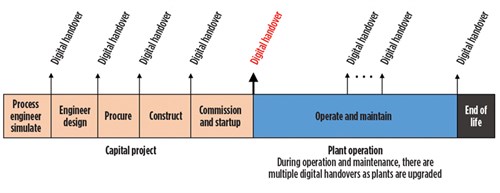Delivering asset data integrity through digitization and standardization
During the lifecycle of an asset—from capital project activities through operations and maintenance and to end-of-life—data about the asset are handed over numerous times, from engineering, procurement and construction (EPC) firms, various supply chain partners, owner-operators, and internally within each of these organizations. During handover events, valuable data can be lost, misinterpreted or keyed-in incorrectly. Tag and equipment data are difficult to manage because they are often in differing formats, exist in various applications and systems, and are transmitted by different means (Fig. 1).
 |
| Fig. 1. Compounded situations often result in abandoned or bad asset data. |
Incorrect or missing asset data leads to more required work to correct or find the information, thus leading to lower productivity and increased costs. Most digital handovers occur during the capital project phase of an asset’s lifecycle, and poor information handover during this phase is often a major contributor to project cost overruns and delays in project startup. It also has been shown to cause difficulty in spare parts planning and maintenance, in the ability to properly train facility personnel, in obtaining permits, and in loading data into a computerized maintenance management system, enterprise asset management or other operational system.
If asset data are kept current and their maintenance status is known, failures and accidents can be mitigated or avoided. Therefore, asset management plays a key role in operational safety, and it is critical to capture and transmit these data in a secure, digitized way to ensure that they are up to date, accurate and easily accessible.
Digitization improves asset data integrity. Improved operations and maintenance can be achieved through predictive and prescriptive maintenance in combination with digital twins of assets. Digital twins—one aspect of digital transformation in an asset-intensive industry—are critical, especially during normal plant operations. The digital twin software should be interoperable with business and operating software applications to allow for straightforward digital handovers.
As plants are upgraded, data are handed over multiple times, similarly to a greenfield capital project. Even when an asset must be decommissioned, associated data should be updated. Whether during greenfield projects, brownfield projects, regular operations and maintenance, or end of life, all asset information handovers should be digitized and standardized (Fig. 2).
 |
| Fig. 2. Digital data handovers throughout an asset’s lifecycle. |
The first step in solving these problems is data digitization. Asset data must be digitized so that they can be programmatically consumed (e.g., not on paper or PDF). After this is accomplished, digitization of the business processes and models is now possible by leveraging digital technologies like application programming interfaces, so that the digitized data can be communicated electronically. Digital transformation is ultimately achieved when business activities, competencies and business models fully leverage digital technologies.
Success can be achieved by accomplishing these goals; however, with multiple software vendors’ point-to-point solutions, the resulting enterprise software architecture will be difficult and expensive to maintain.
Issues with integrating applications. Integrating different software applications, internal and external to an organization, so that the digitized data can be exchanged is not seamless and is an arduous task. Custom integration requires custom development and testing of adaptors. All the burden is placed on the owner-operators, as personnel within these organizations are responsible for ensuring that data can be communicated to and from all systems at all times.
In addition, when software applications are upgraded, modified or changed out, software integration and testing must be performed again. This can be out of an organization’s control if the changes are made by the company with which the organization is exchanging information. An alternative to frequently implementing new releases of an external software application is to change vendors. However, this can come with high switching costs, and owner-operators will ultimately feel the pain of vendor lock-in. Neither approach is ideal.
Inconsistencies also exist in the engineering terminology used by various industry players and individual organizations. Each often have their own reference data libraries (RDLs), requiring this information to also be transformed when communicated during asset information handover.
To eliminate the effort involved in translating the data terminologies and formats, the data must be digitized in an agreed-upon, standard format. At present, many standard (and non-standard) reference models are used in process industries, but none are all-encompassing; therefore, the only viable solution is to integrate all of the most relevant RDLs.
Standardization solves problems. By standardizing digital data formats using multiple libraries and by utilizing web-based services, interoperability can be achieved throughout the entire process industry. When this interoperability is based on published and company-neutral standards, the cost savings and improved data quality can be efficiently shared by the entire group of participating industries, creating the basis for a cross-industry, company-neutral, industrial digital ecosystem.
Several organizations are developing information handover standards to enable this interoperability, including JIP36-CFIHOS, DEXPI, AAS and MIMOSA. Many of these groups came into existence to meet the needs of oil and gas owner-operators. CFIHOS and DEXPI are collaborating, and MIMOSA plans to incorporate the CFIHOS RDL into its RDL library.
To gain wider support for these initiatives and ultimately provide substantial savings for the LNG and gas industries, an introduction to the various standards groups is provided.
CFIHOS, which stands for Capital Facility Information Handover Specification, is a standard for supply chain participants of process industries to provide a consistent, electronic approach to information handover among the companies that own, operate, construct, design and provide equipment for process facilities. More than 60 companies are participating in the development of CFIHOS. The goal is to propose CFIHOS as an ISO 15926-10X standard under TC 184/SC 4/WG3. The following are CFIHOS deliverables:
- A technical specification document: Requirements, rules and principles for information handover
- A dictionary (RDL): Unified naming of equipment, equipment attributes, documents and disciplines according to ISO standards
- A data model: For structuring data and documents about assets
- A process and guidance document: Outlining implementation steps, and what should and should not be done
- A set of requirements for implementation software: Outlining the functional requirements for handover systems.
DEXPI (Data EXchange in the Process Industry) is another emerging standard for digital data exchange, with the working group’s primary focus being to digitize piping and instrumentation diagrams (P&IDs). DEXPI has interfaces to the industry-leading CAE systems most commonly used to create P&IDs. The P&IDs are digitized using the DEXPI information model, which is organized similarly to a unified modeling language class diagram.
Industrie 4.0’s AAS (Asset Administration Shell) defines a standardized, digital representation of assets and their properties in sub-models. It also describes the means to obtain the AAS and asset information securely through various networks. The AAS is designed for both factory and process automation industries. Generic sub-models are available for common Industrie 4.0 assets, and templates are provided to allow the development of individual sub-models. XML and JSON data formats are used to communicate the AAS and its respective asset information, with OPC UA for use in production operations and AutomationML being developed.
MIMOSA was formed to develop supplier-neutral standards to enable complex industrial assets, systems and associated processes to be modeled, monitored and managed wherever they are operated. MIMOSA’s objective is to complete the core requirements for industry digital transformation by 2020.
MIMOSA, in cooperation with the Open O&M Initiative Members and Standards Leadership Council Members (ISA, MESA/B2MML, OPC Foundation, POSC Caesar Association, PPDM and USPI) built the open industrial interoperability ecosystem (OIIE). The OIIE is a supplier-neutral and standards-based industrial digital ecosystem providing interoperability for asset-intensive industries. Fig. 3 describes the OIIE architecture and some use cases.
 |
|
Fig. 3. OIIE inter-enterprise systems connectivity and services architecture. |
The OIIE allows for improved workflows after project completion, when the EPC is no longer the mediator and information is typically exchanged between the owner-operator and original equipment manufacturers (OEMs). Messaging is based on a standardized set of web services to allow for publish/subscribe and request/response events.
The OIIE is further described in the standard ISO 18101-1 Technical Specification being developed by ISO TC 184/WG 6. The objective of this specification is to provide requirements for a supplier-neutral and interoperable industrial digital ecosystem for asset-intensive industries and their supply chains.
Pilots prove viability. The oil and gas interoperability (OGI) Pilot is an instance of the OIIE and is designed to prove the OIIE architecture. Two iterations of the OGI Pilot have previously demonstrated that asset data can be exchanged in an open, standardized format using standardized exchange methods.
The next iteration of the OGI Pilot is underway and is based on oil and gas asset classes and on standard use cases applicable to all process industries. The pilot uses an EPC-developed dataset and involves all supply-chain actors (owner-operators, EPCs and OEMs), in addition to software vendors. MIMOSA is working with end users, engineering software suppliers, EPCs and OEMs to pilot the specification based on several key OIIE use cases spanning capital project to operation.
The pilot is divided into three sub-phases. The first sub-phase covers the following use cases:
- Export the Proteus XML format of P&ID data from the EPC’s engineering systems and transform to CCOM XML for use by owner-operator systems
- In a greenfield project, a request for information based on functional requirements is made by the EPC, with a response of possible model numbers and model datasheet information coming from the OEM
- After procurement, the assets are installed as part of the capital project, and the as-built information is handed over to the owner-operator
- Condition-based maintenance (CBM) is performed by collecting and analyzing measurement data, and by producing the health assessments and outputs required so that action can be taken before failures occur or before efficiency, product quality, etc., are impacted
- Remove and replace maintenance activities are performed as a result of CBM advisories indicating imminent asset failure and allowing proactive scheduling of a remove/replace maintenance work order
- During the lifecycle of a plant or in a brownfield project, a request for information on a serialized asset is made, and the OEM returns appropriate model asset-specific data.
At the end of each sub-phase, a technical report is produced that includes lessons learned, gap analysis and a recommended path forward. The latter will be used in conjunction with industry input to determine the content of the next sub-phases.
Takeaway. Solutions based on supplier-specific ecosystems are inefficient due to a lack of interoperability. New initiatives based on transmitting standardized, digital taxonomies of assets among open and interoperable ecosystems are the preferred path forward in a world embracing Industrie 4.0 and the Industrial Internet of Things (IIoT).
Productivity will improve as secondary business processes related to asset management and data integrity are minimized. These standardization efforts can be accelerated by participating in one or more of the aforementioned standards groups.
Being part of a greater digital ecosystem and utilizing economies of scale will allow organizations to gain access to a full set of standardized data to manage assets throughout their lifecycles, while also reducing risks and costs. GP
 |
Sandra Fabiano is a Systems Architect at Yokogawa’s U.S. Technology Center in Dallas. With a focus on digital data handover, she participates in the MIMOSA group, as well as in other similar standards groups. She holds a computer engineering degree from Concordia University in Montreal and an MBA degree from the University of Texas at Dallas. She has more than 25 yr of experience in software development and consulting in the manufacturing, telecom and banking industries.




Comments